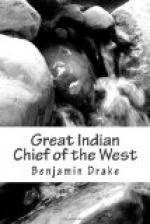“More than a century ago, all the country, commencing above Rock river, and running down the Mississippi to the mouth of the Ohio, up that river to the mouth of the Wabash, thence up that river to Fort Wayne, thence down the Miami of the Lake some distance, thence north to the St. Joseph’s and Chicago; also the country lying south of the Des Moines, down perhaps, to the Mississippi, was inhabited by a numerous nation of Indians, who called themselves Linneway, and were called by others, Minneway, signifying “men.” This great nation was divided into several bands, and inhabited different parts of this extensive region, as follows: The Michigamies, the country south of the Des Moines; the Cohakias that east of the present village of Cohokia in Illinois; the Kaskaskias that east of the town of that name; the Tamarois had their village nearly central between Cahokia and Kaskaskia; the Piankeshaws near Vincennes; the Weas up the Wabash; the Miamies on the head waters of the Miami of the Lakes, on St. Joseph’s river and at Chicago. The Piankeshaws, Weas and Miamies, must at this time have hunted south towards and on the Ohio. The Peorias, another band of the same nation, lived and hunted on the Illinois river: The Mascos or Mascontins, called by the French gens des prairies, lived and hunted on the great prairies, between the Wabash and Illinois rivers. All these different bands of the Minneway nation, spoke the language of the present Miamies, and the whole considered themselves as one and the same people; yet from their local situation, and having no standard to go by, their language became broken up into different dialects. These Indians, the Minneways, were attacked by a general confederacy of other nations, such as the Sauks and Foxes, resident at Green Bay and on the Ouisconsin; the Sioux, whose frontiers extended south to the river des Moines: the Chippeways, Ottoways, and Potawatimies from the lakes, and also the Cherokees and Choctaws from the south. The war continued for a great many years and until that great nation the Minneways were destroyed, except a few Miamies and Weas on the Wabash, and a few who are scattered among strangers. Of the Kaskaskias, owing to their wars and their fondness for spiritous liquors, there now (1826) remain but thirty or forty souls;—of the Peorias near St. Genevieve ten or fifteen; of the Piankeshaws forty or fifty. The Miamies are the most numerous; a few years ago they consisted of about four hundred souls. There do not exist at the present day (1826) more than five hundred souls of the once great and powerful Minneway or Illini nation. These Indians, the Minneways, are said to have been very cruel to their prisoners, not unfrequently burning them. I have heard of a certain family among the Miamies who were called man-eaters, as they were accustomed to make a feast of human flesh when a prisoner was killed. For these enormities, the Sauks and Foxes, when they took any of the Minneways prisoners, gave




